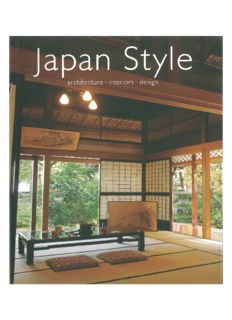‘Japan Architecture’ PDF Quick download link is given at the bottom of this article. You can see the PDF demo, size of the PDF, page numbers, and direct download Free PDF of ‘Japan ArchitectureInteriors , DesignInteriors And Design’ using the download button.
Japan Style Architecture Interiors & Design Book PDF Free Download

Japan Style Architecture
During the 14th century there was a surprising intellectual leap in housing design in Japan.
The idea was so powerful that it reverberated for the next 600 years, and still has substantial influence in Japan as shown in the homes in this book.
This intellectual leap attempted to “eliminate the essential, and to seek beauty in embellishing humble things.
It intentionally sought spaciousness in small spaces and a sense of eternity in fragile and impermanent materials.
The interior of a house was not just to be protected from nature, but to be integrated with nature in harmony. Influential Zen Buddhist priests at Muromachi and Momoyama
The periodicals expressed this ideal so well that thinkers in many fields followed it and the whole of Japanese society aspired to it. The result has been homes that speak to the soul and seem to stand still in time.
They provide a very simple basis for dealing with the world.
Around the time that European and English homes were being filled with exotic bric-a-brac collected from the newly established colonies,
Japanese Zen priests were clearing out the furniture from their homes. Any overt decorations also went out.
All that was left was a simple flexible space that could be used according to the times. The bedrolls on the right were taken from deep shared cupboards, and were changed during the day, creating space for dining, working, playing and entertaining.
This “lightness was in part a response to the frequent earthquakes in Japan, and in part a response to Buddhist teachings about the transient nature of all things.
It is interesting to note that this transience is not reflected in the architecture-enabled tradition in these three countries, India, China or Korea. From where Buddhism arrived in Japan.
replaced, creating space for food, work, play and recreation.
This “lightness” was in part a response to the frequent earthquakes in Japan, and in part a response to Buddhist teachings about the transient nature of all things.
It is interesting to note that this transience is not reflected in the architectural tradition of India, China or Korea, the three countries from where Buddhism came to Japan.
Wood is the preferred building material in Japan.
The country’s Shinto roots have instilled a deep understanding and respect for nature.
Japanese carpenters have proven techniques for drawing out the inner beauty of wood.
Craftsmen often feel, smell, and sometimes even taste the wood before buying it.
Although the stone is available in abundance in mountainous Japan, it was traditionally used for the foundations of temples, palaces, and to a lesser extent houses and warehouses.
Even brick buildings, when first built in Ginza around 1870, went without rent for a long time, as people preferred to live in well-ventilated wooden buildings.
Traditional Japanese builders designed houses from the inside out in much the same way that modern architects claimed to do until about two decades ago.
A house’s exterior evolved from its plan, rather than being forced into pre-conceived symmetrical forms.
Bruno Taut, a German architect trained at the Bauhaus. and who visited Japan in 1933, claimed that “Japanese architecture has always been modern
| Writer | Geeta Mehta |
| Language | English |
| Pages | 228 |
| Pdf Size | 35.9 MB |
| Category | Engineering |
Japan Style Architecture Interiors & Design Book Pdf Free Download
